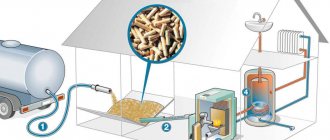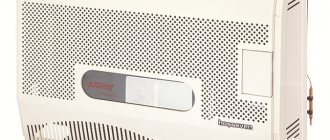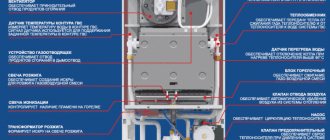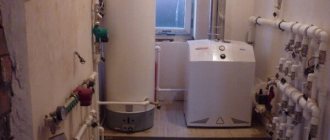For heating private homes and preparing hot water, double-circuit gas boilers are ideal. They work on the basis of transferring to the coolant the energy generated during the combustion of the most affordable and popular type of fuel. However, due to the extensive range of equipment, it can be difficult to choose. Do you agree?
We will tell you how to decide on the most suitable gas boiler model. The article we have proposed provides all the guidelines for choosing a unit with the highest possible efficiency that can withstand intense operating load. Market leading models and trusted manufacturers are listed.
Design features of the unit
A household gas appliance consists of a housing, two communication circuits, a built-in burner, a heat exchanger, an expansion tank, a combustion product exhaust unit, a gas valve and a control unit.
The main circuit is connected to the common heating system in a closed circuit. When the unit is actively operating in heating mode, the coolant circulates through the primary circuit pipes, but does not enter the hot water supply (DHW) communication system, since the path there is blocked by a special valve.
When installing equipment with two circuit elements, you must remember that the length of the communication pipe connecting the boiler to the farthest point of water intake should not exceed 7 meters. Otherwise, mineral elements deposited in the form of scale in the heat exchanger area will begin to interfere with the movement of the working fluid and the productivity of the water heater will significantly decrease
When the user turns on a hot tap in the kitchen or bathroom, the valve is activated, closes the entrance to the heating pipes and directs the coolant to the DHW circuit to warm up the water in the heat exchanger.
From there, the liquid enters the tap and is used for its intended purpose. When there is no longer a need for hot water and the tap is closed, a reverse switch occurs and the valve again redirects the coolant to the heating circuit.
Principle of operation
The principle of operation for all models is approximately the same:
- Automation detects a drop in air temperature to a certain level.
- The pump turns on and water begins to circulate through the system.
- Then the burner lights up, which heats the coolant in the heat exchanger;
- After the coolant reaches the desired temperature, the burner turns off.
- The pump still runs for some time, pushing water through the system until it reaches the desired temperature.
The cycle repeats as soon as the coolant temperature drops below the required level by 1º C.
Water heating occurs according to the same scheme:
- The starting point is the opening of the hot water tap.
- The burner lights up.
- The secondary heat exchanger heats up from the coolant and raises the water temperature to the desired level.
- The flame goes out when the liquid reaches the permissible upper limit or after turning off the hot water tap.
Classification by installation location
According to the installation principle, boilers serving two communication circuits are floor-mounted, wall-mounted and parapet-mounted. Each option has its own special characteristics.
Based on them, the client can choose the most suitable installation method for himself, in which the equipment will be conveniently located, will not “eat up” the usable area and will not cause problems during operation.
Floor-standing boilers
Floor-standing units are high-power devices that can heat and provide hot water not only to a standard apartment or residential building, but also to a large industrial premises, public building or structure.
If a double-circuit boiler is planned to be used not only for heating and supplying domestic hot water, but also for replenishing warm water floors, the basic unit is equipped with an additional circuit
Due to their large size and significant weight (up to 100 kg for some models), floor-standing gas boilers are not installed in the kitchen, but are placed in a separate room directly on the foundation or on the floor.
Features of wall equipment
A mounted appliance is a progressive type of household heating equipment. Due to its compact size, a geyser can be installed in the kitchen or other small rooms. It can be combined with any type of interior solution and fits organically into the overall design.
A double-circuit wall-hung boiler can be placed not only in the kitchen, but also in the pantry. It will take up minimal space and will not interfere with furniture or other household appliances
Despite its small size, a wall-mounted boiler has the same functionality as a floor-standing device, but has less power. It consists of a burner, an expansion tank, a pump for forced movement of the coolant, a pressure gauge and automatic sensors that make it possible to use the fuel resource with maximum efficiency.
All communication elements are “hidden” under a beautiful, modern case and do not spoil the appearance of the product.
The flow of gas to the burner is controlled by a built-in safety system. In the event of an unexpected interruption of the resource supply, the unit’s functioning completely stops. When fuel starts flowing again, the automation automatically activates the equipment and the boiler continues to operate in standard mode.
The automatic control unit allows you to set the device any operating parameters that are most suitable for the user. It is possible to set your own temperature conditions for different times of the day, thus ensuring economical consumption of fuel resources.
Nuances of parapet devices
A parapet boiler is a cross between a floor-mounted and a wall-mounted unit. It has a closed combustion chamber and does not create harmful emissions. Does not require the installation of an additional chimney. The combustion products are removed through a coaxial chimney laid in the outer wall.
A parapet-type boiler is the best option for heating equipment for small rooms with a weak ventilation system. The device is designed so that during operation it does not emit combustion products into the atmosphere of the room in which it is installed.
The device is mainly used to provide hot water and full heating to small houses and apartments in high-rise buildings where it is not possible to install a classic vertical chimney. The basic power ranges from 7 to 15 kW, but despite such low figures, the unit successfully copes with the assigned tasks.
The main advantage of parapet equipment is the ability to connect heating and water supply communications to the central gas system and pipelines from any side convenient for the user.
Construction of a double-circuit gas-fired boiler
The market is rich in a variety of models, which include gas double-circuit heating boilers from a wide variety of manufacturers. Some of them are similar to each other, others have many important differences.
One of the main differences between double-circuit heating boilers is how the heat exchanger is designed, which transfers the heat generated by the combustible fuel to the coolant. In most models, this element is placed at the top of the equipment, under which the burner is located.
When fuel burns, it releases rising heat. The latter heats the heat exchanger through which water circulates. Heat exchange devices can be made of stainless steel, aluminum or copper. However, the most common and resistant to aggressive coolants are stainless steel models.
Double-circuit boilers can be divided into the following two categories:
- With bimetric type heat exchanger
- With two heat exchangers
Bimetric heat exchange models are a “pipe-in-pipe” system. The main external circuit is necessary to ensure heating of the coolant flowing inside the secondary circuit. The main advantage is low cost, however, too high a thermal load can damage the equipment after a short 6-7 years.
Double-circuit gas heating installations with primary and secondary heat exchangers are much more reliable, but they are characterized by a more significant cost. This design works as follows:
- A system of copper tubes onto which copper plates are soldered is used as the primary heat exchanger - it is necessary for heat transfer
- A secondary type heat exchanger (its second name is plastic) is designed to transport heat between the coolant and water to supply the hot water supply line
- When DHW is needed, the coolant moves along a closed circuit inside the boiler, without entering the heating system and giving off heat to the DHW line
Model differences in power
Double-circuit boilers are divided by power into single-stage and two-stage. Single-stage devices always operate at a constant power level and use the same amount of fuel resource year-round.
This is not effective and entails excessive gas consumption, because a house or apartment requires high-quality heating for no more than 5 months a year. At all other times, running the equipment at full power is neither reasonable nor economically profitable.
When installing equipment with a base power of 30 kW, you should know that these types of devices should not be located in residential premises, but in separate rooms equipped with a high-quality ventilation system, individual access to the street and a full-fledged chimney
The functionality of two-stage devices is wider.
With it you can:
- regulate the gas flow regime and rationally consume fuel;
- reduce the number of on/off switches, thus reducing equipment wear and extending its service life;
- reduce the volume of harmful emissions into the air to a minimum.
Additionally, the device is equipped with a smooth switching module, which reduces energy consumption and allows you to simultaneously operate a boiler and a boiler of any capacity, installed separately.
Criterias of choice
When purchasing, be sure to familiarize yourself with the technical characteristics specified in the device passport.
We pay attention to the following indicators:
- Thermal power. Usually the manufacturer gives its minimum and maximum value. For example: 8.0-24.9 kW.
- Water heating speed. The technical characteristics do not indicate the actual t of water, but the value of its rise from the moment it enters the plate circuit until it exits to the mixer. For example, t of water in the system is 17° C, with a given ∆ t of 25° C at the outlet it will be 42 º C.
- Heat exchanger material and type.
- View of the combustion chamber.
- Burner type.
Types of working gas burners
A gas burner can be atmospheric or pressurized. The first type has a simple design and does not produce any noise during operation. The module is cheap and, as a rule, is included in the basic package of the boiler.
Despite its simplicity, the atmospheric burner is very reliable and works well for a long time. Can be used both on budget devices and on expensive, “sophisticated” luxury products
The operating principle of an atmospheric burner is reminiscent of the operation of industrial hearth models. The fuel resource is supplied through an ejector and, due to draft, absorbs air from the surrounding atmosphere. Through a special hole, the mixture enters the combustion chamber and immediately ignites.
As a result, fiery tongues of flame with a very low actual temperature appear above the outlet holes, the task of which is to heat the coolant to the required level.
Pressurized (mounted) burners demonstrate a high level of efficiency, constantly maintaining the set temperature both in the coolant itself and in the hot water supply system, but they are much more expensive than their atmospheric counterparts.
However, these costs are justified, since the modules have expanded functionality and make it possible to use fuel resources as wisely as possible, without reducing the level of comfort of the home.
A pressurized (mounted) type burner is not included in the basic set of a double-circuit gas boiler. It is purchased separately and then installed on heating equipment
During full operation in pressurized burners, the air supply is forced, and its volume is very clearly controlled by internal automation. The module is installed in devices equipped with a closed combustion chamber operating with supercharging.
Fuel and air are mixed not inside the system, but at the outlet. The operating process of the device is almost completely automated and does not require human control.
Atmospheric burners are installed in dual-circuit heating devices with a power of up to 80 kW. Supercharged (mounted) modules are being implemented into large-sized units with a capacity of up to several thousand.
Gas double-circuit wall-mounted boiler: how to choose
The desire of many apartment owners to achieve maximum autonomy and independence from city utilities is quite understandable. One of the main issues in this regard is creating your own heating system. This allows you to independently determine the start and end dates of your “local heating season”, setting the desired temperature in the premises at any time of the year, without freezing if the cold in the fall came too early or the arrival of spring was too long, and without suffering from the heat if the situation develops in a diametrically opposite way. And from the point of view of payment for services, it turns out to be much more profitable. Therefore, the installation of individual heating boilers is becoming an increasingly popular trend among homeowners.
Gas double-circuit wall-mounted boiler: how to choose
Well, if the owners plan to create their own autonomous heating system, then it would be quite reasonable, in parallel with this, to immediately resolve the issue of independent hot water supply. It is no secret that almost everywhere with the supply of hot water various “surprises” occur throughout the year, and in addition, prices for utilities tend to constantly increase. Thus? own heating and hot water supply system means not only “technical”, but also, to a certain extent, financial independence. In addition, an important aspect is the gas consumption in the boiler.
Of course, the limited space conditions of apartments in multi-storey buildings limit the owners in the choice of boiler equipment. However, there is a way out - this is a double-circuit wall-mounted gas boiler, how to choose which will be discussed in this publication.
Operating principle of double-circuit boilers
Today, in cities, network gas remains the most inexpensive source of energy. If a multi-storey building is connected to a gas main, then for sure, despite certain administrative and technological difficulties in installing the appropriate equipment, such a heating and hot water supply system will become the most profitable. By paying bills only for the actual consumption of “blue fuel”, the owners receive in return both independent heating and an uninterrupted supply of hot water for household needs. Moreover, the timing of switching on and the heating temperature all depend on the wishes of the apartment owners.
With a certain simplification, the principle of connecting a double-circuit boiler can be schematically depicted as follows:
Approximate connection diagram for a double-circuit boiler
The boiler itself (item 1) is placed on the wall in the most convenient place, where there will be a connection to the gas main (item 2) and to the combustion product removal system.
Hot water circuit. A cold water supply pipe is connected to the boiler (item 3, blue arrows). Heated water is distributed (pos. 4, red arrows) through a collector or corner circuit to points of consumption - in the bathtub (pos. 5), shower stall (pos. 6), kitchen sink (pos. 7), etc.
The heating circuit is closed. The circulation pump (most often it is a structural unit of the boiler itself) ensures the movement of the coolant through the supply pipes (item and return pipes (item 9). Depending on the specific features of the heating system, ordinary radiators (item 9) can be connected to the heating circuit. 10), water heated floors (pos. 11), convectors of one type or another (pos. 12). If desired, other devices can be embedded here, for example, heated towel rails (pos. 13).
The circulation pump (most often it is a structural unit of the boiler itself) ensures the movement of the coolant through the supply pipes (item and return pipes (item 9). Depending on the specific features of the heating system, ordinary radiators (item 9) can be connected to the heating circuit. 10), water heated floors (pos. 11), convectors of one type or another (pos. 12). If desired, other devices can be embedded here, for example, heated towel rails (pos. 13).
Thus, five pipes fit and connect to the wall-mounted double-circuit boiler:
- Gas main.
- Supply of the heating circuit with further distribution to priors or heat exchange systems.
- "Return" of the heating circuit.
- Cold water inlet
- The outlet of the heated water supply system for domestic needs with subsequent distribution to water intake points.
Inside the boiler itself, both circuits - heating and hot water supply - do not directly intersect, which makes it possible, if desired or necessary, to use a special coolant in the heating circuit.
By and large, this is a fundamental difference with single-circuit boilers, many of which have the ability to connect to a hot water supply system, but only through an indirect heating boiler.
Differences in the connection diagram of a boiler with an indirect heating boiler
Look at the diagram. Everything seems to be the same, but the points of consumption of hot domestic water are connected to an indirect heating boiler. And this, in turn, is connected to a dedicated boiler circuit, through which the same coolant circulates as in the heating system.
Even if such a boiler has four water pipes at the outlet - two for heating circuits, and two for an indirect heating boiler, it will still not be considered double-circuit. It’s just that its internal design provides for rational redistribution of coolant flows with the necessary automation of this process. But the heat exchanger is used alone, and the composition of the liquid circulating in both circuits is no different.
A system using an indirect heating boiler has a number of significant advantages. In particular, it is possible to organize local closed recirculation of hot water supply - at any time, whenever the tap is opened, hot water at the set temperature will immediately flow out of it.
You may be interested in information on how to choose a voltage stabilizer for a gas boiler
But there are also several negative aspects. Firstly, the cost of such a kit is always quite high. And secondly, and for small apartments, perhaps the most important thing, installing a boiler and boiler will require a considerable area, which is not always possible.
It is in such conditions that a double-circuit wall-mounted boiler will help out. Its main advantages:
- Compactness - it does not take up much space, and at the same time, as a rule, does not disharmonize with the kitchen interior.
Wall-mounted boilers fit well into the interior
- Two problems are solved at once - heating the apartment and meeting the needs for hot water. The owners largely get rid of the “whims” of public utilities.
- Such boilers, when installed correctly and with a well-thought-out, balanced autonomous heating system, are very economical - this will certainly be immediately noticeable in the amount of monthly utility costs.
- The total cost of purchasing and installing a double-circuit boiler will be significantly lower than for a single-circuit boiler with an indirect heating boiler.
However, double-circuit boilers are not without significant disadvantages:
- These devices operate in only one mode at a time. For example, if it is necessary to heat domestic water, the boiler switches completely to water supply, temporarily turning off the heating circuit.
- As in the case of a gas water heater, there is a certain “inertia” - when you open the tap, you will have to wait until the cold water remaining in the pipes flows out and until the boiler “accelerates” to the desired heating temperature.
- Many double-circuit boilers are very limited in the volume of heating running water. So, taking a shower and washing dishes at the same time will either not always be possible or uncomfortable - when you close one tap, a temperature jump will inevitably occur in the other. True, many modern devices are equipped with an internal boiler, which eliminates this disadvantage.
Overgrowth of heat exchanger channels
- If in a single-circuit boiler the purity of the coolant can be achieved, then in a double-circuit boiler, tap water is also heated, which is not always and not always of different quality. This poses a certain risk of overgrowth of the heat exchanger tubes, which will either have to be cleaned regularly or replaced with new ones.
Which double-circuit wall-mounted boiler should I choose?
The boiler connection diagram shown above is very arbitrary, and in no way covers the variety of these devices. So in order to correctly determine the right model, it is necessary to take a closer look at the main selection criteria.
Boiler power and performance
- The boiler must fully cope with its main task - to ensure the operation of an autonomous heating system. This means that one of the basic selection criteria is its thermal power.
Experts calculate the total amount of heat required by an apartment or house based on many factors - from the area and volume of the premises to the material of the walls, the degree of insulation of the building and the climate zone of residence. To independently determine the required boiler power, you can, with acceptable simplification, proceed from the standard of 10 m² of area of sealed premises per 1 kW. this rule will be valid with an average ceiling height of up to 2.5 - 3 m, and if the rules of proper thermal insulation are still followed in the house (apartment).
It is clear that the heating device should not operate at the peak of its capabilities, so it is better to provide a certain reserve, especially in the case when the insulation of a high-rise building still does not inspire complete confidence. Plus, the boiler needs additional power to heat water. In a word, it would not be a mistake to add another 30 ÷ 35% to the obtained value.
Most modern double-circuit boilers have a fairly wide power range. Technical documentation usually indicates its minimum and maximum values. For example, useful thermal power: 9.3 ÷ 14 kW.
- The second component of the problem is the performance of the device for heating water for domestic needs. If there is no boiler, then heating will be carried out according to a flow-through circuit, and the selection parameter depends on the number of water points that can operate simultaneously. It is clear that the more liters per minute the boiler can heat, the better.
Typically, the technical documentation of double-circuit boilers indicates several performance values, with different indicators of the temperature difference at the inlet and outlet. Usually they operate with the values Δt° = 25 and 35 degrees. This is not the temperature of the water at the outlet, but rather the increase in its value compared to the input. For example, in the summer, the water in the water supply may be 15° C, and at Δt° = 25°, 40° will flow into the taps, which is quite enough for taking a shower.
In principle, a productivity of about 10 ÷ 11 l/min at Δt° = 25°C, and 7 ÷ 8 l/min at Δt° = 35°C is considered very good performance.
All these considered characteristics will be valid only if the gas pressure in the main and water in the water supply correspond to the parameters specified by the manufacturer. You should also pay close attention to this.
Type and number of heat exchangers
According to the principle of heating water for domestic hot water, boilers can vary significantly. So, there are two main types of such devices - with a secondary heat exchanger and with a bithermic one. Each type has its own characteristics.
The main heat exchanger of the boiler, which is responsible for the most energy-intensive function, heating, is always located above the gas burners. And water heating can take place in the same place, or with heat transfer from the heated coolant through an additional device - a secondary heat exchanger.
Double-circuit boilers with a secondary heat exchanger
The primary heat exchanger itself is a metal structure - a curved pipe, the turns of which are united by plate ribs to increase the heat exchange area from the hot combustion products to the circulating coolant. In this version of the boiler, such a heat exchanger has two pipes - inlet and outlet.
Boiler primary heat exchanger
Heating of water for domestic needs is carried out in a secondary heat exchanger, which is located below the combustion chamber and has no contact with the burner flame. Typically this element has a compact plate design.
Secondary heat exchanger - more compact, plate type
There are already four pipes here, and inside there are two circuits for counter-flow of liquid. In one way, the heated coolant circulates, giving off heat, in the second, tap water receives it.
The operating principle of such a boiler is shown in more detail in the diagrams.
- The boiler is operating in heating mode.
Boiler operation in heating mode
Above the gas burner (item 1) there is a primary heat exchanger (item 3). The combustion of gas supplied through the line (yellow arrow) leads to heating of the coolant in the circuit. The circulation pump (item 5) ensures the movement of liquid through the heating pipes. The three-way valve with a servo drive (item 7) is in a position in which the valves open the flow from the return of the heating circuit and at the same time close the entrance to the secondary heat exchanger.
Prices for Baxi gas boilers
gas boiler Baxi
As a result, circulation occurs “in a large circle”, through heating collectors and installed heating devices.
The diagram additionally shows the built-in expansion tank (item and safety group - safety valve and automatic air vent (item 9).
and safety group - safety valve and automatic air vent (item 9).
- What happens when you open a hot water tap?
Operation in water heating mode for DHW
Water flow begins through the pipes of the DHW circuit. This causes the flow sensor turbine (position 6) to rotate. The signal from the sensor enters the automation unit, where a control pulse is generated to the three-way valve (item 7). The valve moves to the position in which the valve closes the inlet from the heating return, but opens the inlet to the secondary heat exchanger. In this case, the pump does not turn off, ensuring the circulation of the heated coolant in a “small circle”.
While using hot water, the circulation of coolant through the heating circuit is suspended.
In the event that this happens during a period when the heating is completely turned off, when the hot water tap is turned on, the flow sensor will transmit a signal to the control unit, which will start the circulation pump, open the gas valve and trigger the electronic igniter (item 2). The gas heaters (item 3) are ignited, and the circulation of the coolant begins through the secondary heat exchanger, transferring thermal energy to the water.
Advantages of boilers with a secondary heat exchanger:
- Double heat exchange eliminates the possibility of getting burned by overheated water. Under any circumstances, if the temperature in the primary circuit can reach 80 ° C, then in the secondary circuit it will not rise above 60.
- For the same reason, and also because heating occurs exclusively during circulation in both circuits at the same time, the build-up of scale in the secondary heat exchanger is much less than in boilers with a bithermal heat exchanger.
- The primary heat exchanger tubes can be made thicker and are less at risk of clogging or fouling.
- Even a clogged primary heat exchanger can be washed and cleaned.
- Such a boiler is more maintainable - each unit can be removed, cleaned or even replaced. The cost of each heat exchanger separately is not so high.
Disadvantages of boilers with secondary heat exchange in the DHW circuit
- The price of such equipment is higher than with a bithermal heat exchanger.
- The presence of an additional electromechanical valve (three-way valve) is an extra vulnerable point for breakdown.
Video: a short “lecture” on the construction of a wall-mounted double-circuit boiler
Boilers with bithermal heat exchanger
In these types of boilers, both heat exchange circuits are combined into one structural unit.
Bithermal heat exchanger - outside view...
Externally, the heat exchanger seems to be similar to the primary one, which was already mentioned above. But there are only four pipes - a pair each for heating and hot water supply.
... and he is in the cross-section
If you look at a cross-section of such a heat exchanger, you can see that the tubes have a cellular structure. Hot water circulation circulates through the central channel. External channels (in this case, four) are intended for circulation of the heating system coolant.
If only the heating is turned on, the circulation pump ensures the movement of the coolant, and the water in the central channel is motionless.
Scheme of operation of a boiler with bithermal heat exchange
When you open the hot tap on the mixer, under the influence of the water supply pressure, water begins to move through the inlet pipe (item 1) towards the outlet pipe (item 2). The flow sensor through the control unit turns off the circulation pump of the heating system, and the movement of the coolant stops. The heat from the burners is taken over by the heated water. When the tap is turned off, the pump resumes operation, and the heating system becomes the main one.
Advantages of such a scheme:
- One heat exchanger takes up much less space. In addition, there is no three-way valve with a servo drive or additional piping. This makes the entire structure of the double-circuit boiler much lighter and more compact.
- Although a bithermal heat exchanger is a rather complex part in terms of manufacturing technology, its cost is still lower than two separate heat exchangers. This also affects the price of the boiler.
The disadvantages are very significant:
- In any mode, in one of the heat exchanger circuits the liquid is stationary, but is subject to heating. This leads to fairly rapid scale formation and overgrowing of the channels.
- The relatively narrow clearance of all channels also leads to the same consequences. Overgrowth of at least one of them leads to a decrease in boiler performance and the appearance of unpleasant noises.
- While the hot water supply circuit is closed, the water continues to heat up and reaches the same temperatures as the heating fluid. When you open a tap, very hot water may initially flow, which can scald your skin. To minimize such a risk, they try to limit the overall heating temperature using hardware and software methods (not higher than 70 ÷ 75 ° C, although this is already too much). But such a reduction simultaneously entails a reduction in the possible thermal output of the boiler for the heating system.
- A bithermal heat exchanger is more difficult to manufacture, and the presence of a large number of joints greatly increases the likelihood of leaks. Cleaning such a structure from scale is much more difficult. Well, if a leak occurs (especially between the external and internal circuits), such a heat exchanger is practically beyond repair and requires mandatory replacement. But its cost is much higher than both primary and secondary in other types of boilers.
Thus, in terms of these positions, a boiler with secondary heat exchange in the hot water supply circuit still looks preferable.
Prices for Vaillant gas boilers
Vaillant gas boiler
There is another innovative type of double-circuit boilers - with a condensation-type primary heat exchanger. They are designed with an eye to a fairly serious effect of saving gas consumption at the same or even higher thermal power levels.
Double-circuit condensing boiler
The fact is that one of the combustion products of natural gas is always water vapor. In conventional boilers, it is simply released into the atmosphere, and meanwhile its thermal energy (temperature reaches 110 - 140 ° C) can additionally be used to heat the coolant.
One of the models of condensation type heat exchangers
A special heat exchanger device ensures steam condensation with heat release. Studies have shown that steam potentially stores up to 11% of the total heat generated by the boiler, and if their unreasonable losses are returned to heat exchange, then gas savings over the season can reach 30% of the usual consumption level.
Of course, such energy-saving boilers are the future, and in many countries they have taken leading positions in popularity. The only thing that still holds them back from widespread use in our area is the very high price.
Type of combustion products exhaust system
Boilers are divided into two large subgroups - with an open combustion chamber and with a closed one. Accordingly, they are spilled into systems for supplying the air necessary for gas combustion and for removing combustion products into the atmosphere.
Chimney boilers with an open combustion chamber
An open combustion chamber assumes that air enters the burners naturally, from the room in which the boiler is located. The combustion products, also naturally rising upward, are redirected to the pipe to which the chimney pipe is connected. In a word, the effect of natural draft is used, based on the difference in the density of cold and heated gases.
This is what a boiler with an open chamber looks like with the casing removed
The advantages of such a boiler:
- The operation does not require a special fan. This means the absence of noise and lower power consumption of the boiler.
- The contraction does not have complex air injection and control elements (pneumatic relays), therefore, the overall reliability of the device is higher.
- A chimney assembled in accordance with all the rules solves the problem of condensation formation.
- Chimney boilers are cheaper than turbocharged boilers.
Flaws:
- Air enters the combustion chamber directly from the room. This means that the issues of constant supply ventilation should be considered. And this very often leads to excessive heat loss in the premises and the appearance of drafts.
- There are special, fairly strict rules for the design and installation of a chimney. This often leads to large-scale repair and construction work and serious expenses - otherwise you will not be able to obtain permission to install the boiler.
- Installing a chimney is not possible in principle in all buildings.
Flueless boilers with a closed combustion chamber.
Such boilers are often called turbocharged. The air for them is supplied from the street forcibly, using a special fan-turbine; accordingly, combustion products are also thrown out into the street by the created pressure.
A turbocharged boiler always indicates the presence of a fan
The chamber itself is completely closed, and exhaust gases cannot enter the room.
The supply of air and the emission of combustion products can be carried out through two separate pipes, but the vast majority of modern boilers of this type provide for the installation of a coaxial system - a “pipe in a pipe”, which is discharged through the wall to the outside.
Coaxial chimney
Inside the outer pipe, usually 100 mm in diameter, a second pipe with a diameter of 60 mm is located coaxially. Through the space between the outer wall and the inner pipe, air is forcedly drawn in from the street. The internal channel serves for the exit of combustion products.
Advantages of such a system:
- There are practically no significant restrictions on its installation.
- There is no need to provide fresh ventilation in the room.
- The cost of such boilers is slightly higher, but it is fully justified by the absence of large-scale work on the design and construction of the chimney.
The disadvantages are the following:
- A significant temperature difference in the outer and inner pipes is accompanied by the formation of condensation. In severe frosts, this can lead to icing, impairing the permeability of the chimney and, accordingly, insufficient vacuum in the chamber for the automation to operate.
- Mandatory elements of the system are a pneumatic relay, a fan and a fan switch relay. All of them have a certain resource, and failure of any of them leads to failure of the boiler.
- The fan creates noise when operating. In addition, this is an additional energy consumption.
Conclusion: a boiler with an open combustion chamber and a conventional chimney looks more reliable in operation. But turbocharged boilers are easier to install and have no special restrictions on the installation location.
You may be interested in information on how to choose an electric boiler for heating
Controls, automation, protection levels
The boiler must be fairly easy to use, have clear controls, be equipped with the necessary functions to optimize operation and several degrees of protection against emergency circumstances.
Modern boilers are equipped with convenient display and control panels
Leading manufacturing companies are constantly improving their models, thereby creating competition between brands, so new developments are constantly appearing. Thus, modern boilers can be equipped with the following options:
- Flame modulation in heating and water heating modes. The flame level is electronically regulated, ensuring smooth starts, which is especially important for models with instantaneous heating of DHW water. The automation independently selects the height of the flames depending on the set temperature and the specific current water flow.
In some models, the last 5 degrees to the set heating temperature of the heating system are gained at a reduced combustion intensity. This allows you to make the operation of the device smoother, reduce the number of starts, and therefore increase the service life of the equipment.
- Similar goals are pursued by a smooth electronic ignition system, when after the appearance of a minimum flame on the burners, it gradually grows to a given combustion intensity within 30 - 40 seconds.
When the boiler operates as a water heater, this option does not apply - what is important here, on the contrary, is the speed of heating the water to a given level.
- Weather-compensated boiler automation. This innovation, when installing an external street sensor, allows the equipment to monitor the level of external temperature and make adjustments to maintain an optimal microclimate in the apartment.
More advanced equipment of this type also has an automatic self-adaptation function. Electronics not only compares graphs of changes in external and internal temperatures, but also conducts an analysis, making adjustments to the operation of the boiler, which leads to maximum comfort and significant gas savings.
- Pump post-circulation. A useful function that, when a room thermostat is installed, can significantly reduce energy consumption. Once the required heating temperature has been reached in the heating system, the boiler turns off and the pump continues to operate for another three minutes. When it is necessary to resume operation, both the boiler and the pump are started simultaneously.
- Naturally, all modern electronically controlled boilers allow you to accurately set the temperature in both the heating circuit and the DHW. In addition, some models provide two switchable ranges in heating mode - for conventional radiators and for heated floors.
- The electronics allow programming of the boiler operation for a certain period of time, with the programs being stored in memory for reuse.
- Any gas equipment has several degrees of protection - in case of insufficient draft, in case of heater extinguishing, in the absence or insufficient water pressure in the circuits, etc. In addition, modern models are equipped with other safety functions. So, if the temperature in the circuits drops to +5 degrees, the boiler will start on its own to bring the heating level of the coolant and water to a safe value, in order to avoid freezing. In addition, some control systems also monitor the condition of the boiler elements. If the device has not been used for more than a day, the processor will turn on the pump for a short time or switch the position of the three-way valve back and forth. This allows you to avoid blocking or “sticking” of these units and extends their service life.
Panel with push-button control and combined, arrow and LCD indication
Control panels can have push-button, touch or electromechanical control, and are equipped with dial or digital indicators of temperature and pressure in the system.
Prices for popular gas boilers
Dimensions, “appearance”, manufacturing company
A mandatory evaluation criterion should be the dimensions of the boiler - they must correspond to the dimensions of the place where it is planned to be installed. This takes into account both the location of the gas main and the possibility of connecting to a chimney or installing a coaxial system. There are certain restrictions in these matters, for example, on the length of the coaxial pipe - this must be clarified in the product passport.
Boiler with built-in boiler
You may be interested in information on how to choose an electric boiler for heating a house of 100 square meters
Perhaps, if the installation area allows, it makes sense to purchase a boiler with a built-in boiler - its dimensions are certainly larger, but its ease of use is incomparably higher - this has already been mentioned.
For many owners, an important selection criterion is the design of the boiler. It is difficult to give advice here - the main thing is that the device does not spoil the interior. Most of the boilers have a matte white finish, which fits perfectly into any style.
No matter how much you like a particular model on sale, you should always give preference to reputable brands. Leading manufacturing companies provide a solid guarantee for their equipment, and since the boiler can be considered an expensive purchase, this fact is very important.
Very popular modern model “Baxi - Luna3″
European companies, Beretta, Baxi, Vaillant, Bosch, enjoy well-deserved authority and an untarnished reputation. Protherm, Buderus, Ariston and other companies have proven themselves well. You can completely trust the products of Korean, Daewoo, Celtic, Kiturami - in terms of equipment with modern electronics, they are sometimes superior to Europeans.
Video: wall-mounted double-circuit gas boilers Daewoo
You should be careful with Chinese technology, despite its relatively low price. Well, a brand “unknown to science” should be discarded immediately, no matter how attractive the model may seem.
When choosing between manufacturers, you should clarify whether there are service centers in the region, how difficult it will be to send equipment for maintenance or for replacement due to a complaint. Probably, you should not purchase a boiler from even the most popular manufacturer, if in a given area it is “exotic”, and the search for any trifling detail will be difficult.
You may be interested in information about what types of wall-mounted double-circuit gas heating boilers are available, prices, reviews
So, in order to choose a truly high-quality wall-mounted double-circuit boiler that is fully suitable in all respects, you should evaluate many criteria, understand the device, carefully study the technical documentation for the model you like, and compare its technical characteristics with the existing conditions of the planned operation. You should not chase the cheap - this purchase is made with the expectation of many years of service, and the stingy, as we know, pays twice.
Types of ignition function
A household double-circuit boiler is started manually (using matches or a lighter) or using built-in elements (electric ignition or piezo ignition). The first method is the simplest and most accessible. The second makes it possible to save blue fuel by not leaving the wick in the igniter to burn constantly.
There is only one disadvantage of this option - dependence on the availability of electricity in the network. If for some reason the power stops flowing, the equipment immediately turns off and is automatically activated again when the electrical supply is restored.
Piezo ignition is absolutely safe and allows you to turn on the boiler by pressing just one button. The element does not depend on the supply of current and you can use the equipment even in the absence of electricity.
Equipment traction options
During operation of the unit, fuel burns and flue gases are generated. To remove them from a living space, natural or forced draft is necessary. It will ensure timely removal of all combustion products and released harmful substances from the apartment or house.
Natural draft modules
Boilers operating on natural draft have a simple design and take the air necessary for proper combustion from the room in which they are located. During intensive use, a certain amount of steam and various chemicals are released. Emissions are removed through a vertical chimney.
Among the main advantages of units with natural draft are reasonable cost, energy independence and absence of noise effects during operation.
In general, devices with natural draft are convenient and good, however, when the pressure in the gas pipeline drops, the quality of their work decreases significantly. At the same time, the risk of rapid burnout of the burner increases, since the fire at a reduced pressure level dies out or goes inside the burner device.
Uneven pressure in the main networks provokes serious overconsumption of fuel, which entails an increase in the amount of utility bills.
Forced draft devices
Boilers with forced draft are sometimes called forced-air or fan-type. They take air not from the room where they are located, but from the street. The modules have closed combustion chambers, and waste substances are emitted through a coaxial horizontal outlet using a powerful fan built into the system.
A coaxial bend consists of two pipe elements of different diameters inserted into one another. Through the smaller pipe, combustion products exit the room, and through the space between the small and large pipes, fresh air enters the room from the street, which is necessary for the full functioning of the boiler
Products with forced draft are easy to install, do not make any demands on the location, do not “eat up” oxygen in residential premises, work stably and accurately even with reduced gas pressure in the central main networks and do not require the installation of an additional vertical chimney.
The devices are criticized for the noisy operation of fan elements, higher cost and dependence on power supply.
Distinctive features of heat exchangers
The heat exchange unit of the heating device can be cast iron, steel or copper. The cast iron version retains heat for a long time, is almost not subject to corrosion due to the high wall thickness and is resistant to aggressive coolants. It is heavy and therefore mainly integrated into floor-standing boilers.
Requires great care during installation, since any impacts violate the structural integrity of the material and lead to the formation of microcracks.
The steel structure weighs little, is not afraid of mechanical stress, can easily withstand temperature changes in the coolant, and is easily transported and installed. Has some tendency to corrosion. The boiler control system helps to avoid it, which prevents the coolant temperature from falling below the critical point.
Copper elements are an order of magnitude more expensive than their cast iron and steel counterparts, but they compensate for the substantial cost with a large number of advantages. Inside the copper heat exchanger, sediment and scale are formed to a minimum and do not interfere with the normal circulation of the working fluid. The walls of the device are heated evenly and do not cause local overheating of the coolant.
conclusions
You can independently plan and install a heating system in a private house if you correctly calculate the power and choose the type of boiler. One of the most convenient and economical options is a double-circuit wall-mounted gas boiler, which has not only various functions, but also an attractive appearance.
You can install the equipment yourself, but it is advisable to turn to professionals, since the connection will be to both the gas main and the water supply, and these actions require considerable technical knowledge. To make it easier to choose the right equipment model, look at user ratings and reviews for each specific model.
Advantages and disadvantages of gas systems
In places where central gas communications are laid, double-circuit boilers are very popular. They are purchased for heating and uninterrupted supply of hot water to apartments, residential buildings and country cottages.
The main advantages of the devices
The gas system demonstrates a high level of efficiency, delivers several times more energy than it consumes, lasts a long time and operates smoothly. Does not require constant human supervision.
The double-circuit boiler looks neat and modern. Unlike units operating on solid or liquid fuels, during operation it practically does not emit unpleasant odors and creates a minimum of soot and soot
The fuel resource is supplied to the installation continuously, and the built-in controller independently monitors the presence of fire on the burner. If the flame dies out, the sensor sends a signal to the ignition unit and the automatic supply of a spark instantly restores the fire. Controlling the boiler is simple and does not present any difficulty.
Disadvantages of dual-circuit equipment
The main disadvantages are associated not so much with the device itself, but with the process of its legalization and installation. You can’t just buy a boiler, bring it home and install it yourself according to the connection diagram. First, you will have to comply with a lot of technical nuances, draw up documentation and coordinate all subsequent actions with the local gas supply company.
There you will need to provide:
- equipment installation project, drawn up in accordance with the norms adopted by law;
- installation agreement with a specialized organization;
- a copy of the license of the specialized organization confirming the right to carry out work.
In addition, you will need to organize the removal of exhaust gas from the living space, lay an additional chimney for this or use an existing old one, and install additional equipment to control potential gas leaks.
If the boiler smokes, perhaps the pressure in the system has decreased or the existing burner has worn out and begun to burn out. A specialist with relevant experience will help you quickly fix problems
The main installation activities can begin only when the project documentation for the organization of gas heating has passed all stages of approval and the client receives a stamped permit for the installation of the system.
Condensing boilers for low temperature heating systems
Having appeared relatively recently, “warm floor” systems are now becoming increasingly common as the main ones, especially in new houses and apartments with individual heating. They manage to implement them even on wooden joists, not to mention slab foundations, ground floors and concrete floors. The main difference between a heated floor and a radiator piping is not even the laying of the line in the screed, but the low temperature of the coolant and efficiency due to lower fuel consumption and high thermal inertia. Traditional gas boilers are used in such systems, but a condensing boiler will work more efficiently in it. It is characterized by increased efficiency due to the removal of thermal energy from flue gases, but in order for the equipment to function at full efficiency, the temperature in the “return” must be less than 55˚C. And these are just the parameters of warm floors or warm walls, but the latter are practically not found in our country.
In tandem with a heated floor, a condensing gas boiler will allow you to consume less gas, which is vitally important given the enviable stability of tariff growth. Condensing boilers also have one more undoubted advantage - the ability to operate at a power several times lower than the nominal one. Do not clock, switching on and off, but work in optimal mode.
SirazhudinForumHouse Member
I laid 70 square meters in my apartment. pipes for TP made of cross-linked polyethylene, 20-diameter, 5 circuits, about 400 m. In general, the next stage is choosing a boiler, since I only have a heated floor without radiators, I decided to buy a condensing type boiler. The store told me that they have a 400 sq.m. condensing boiler. So the question is, is it possible for me to install a boiler with such a reserve on my 70 sq. m. and will it work correctly?
Sergey BugaevProduct Specialist
It is better for you to pay attention to boilers of lower power; 24 kW will be enough. In general, gas condensing boilers have a higher modulation range, and they can easily operate in a small area even in spring and autumn. With a minimum power of 2.4 kW it will correspond to 24 kW.
The latest generation wall-mounted condensing boilers are characterized not only by efficiency and a large modulation range, but also by expanded functionality.
- Efficiency – up to 109.8%.
- Energy efficiency – A+.
- Weather-dependent regulation - maintains a constant temperature in the rooms, reducing or increasing power, depending on the ambient temperature.
- Built-in Wi-Fi module, remote control.
- Possibility of integration into a smart home control system.
Even the most reliable European equipment needs service in order for the boiler to be guaranteed; the installation must be trusted not just to professionals, but to certified installers. The process itself does not require any special manipulations, there is only one nuance.
polshinForumHouse Member
...Is the boiler piping and installation of the heating system of a condensing boiler very different from a conventional one?
Sergey BugaevProduct Specialist
There is only one difference: condensing boilers have condensate drained into the sewer system. This is a small tube through which condensate flows in a weak stream.
If we are talking about a private house with local treatment facilities, condensate in its pure form cannot be discharged into the sewer system. It must be pre-treated in a specialized neutralizer (a container with marble granules).
Review of popular manufacturers and models
The market for modern gas equipment offers customers a large number of high-quality appliances designed for heating residential premises and supplying hot water.
Among the mounted units, the most popular are:
- Navien DELUXE 24K (South Korea) - efficiency, good functionality and reasonable cost;
- Baxi MAIN 5 24 F (Italy) – budget price, high level of efficiency, long service life;
- Vaillant turboTEC pro VUW 242/5-3 (Germany) – reliability, high-quality heat transfer.
In addition to the above qualities, the models are distinguished by their attractive appearance, compact dimensions, fit into a variety of interiors and can be easily placed even in small rooms with complex layouts.
A gas appliance with two circuits from the German company Vaillant has a convenient control knob and a display on which you can see the level of heating of the coolant at the moment
Of the floor-standing units, the most popular are the high-power (30 kW) ATON Atmo 30E, the practical Lemax Premium-25B and the more expensive, but very functional Navien GA 17KN.
Navien GA 35KN, despite its high power, uses fuel reasonably and allows owners to save on utility bills without compromising personal comfort
Baxi SLIM 2.300 Fi and Protherm Bear 40 KLZ are part of the premium line of equipment. They have advanced functionality and reliably serve for many years. In all parameters and physical characteristics they comply with the most stringent European standards (confirmed by certification certificate CSQ and UNI EN ISO 9001).
For a small room (up to 50 sq.m.), a boiler with a base power of 7 to 12 kW is suitable. If the real estate area is larger (for example, 150-200 sq.m.), it is better to purchase a 23-25 kilowatt device
Weak units simply cannot provide full heating to an apartment or large house.
You should buy floor-standing gas boilers and wall-mounted models only in branded stores or official representative offices of manufacturing companies. There, the client will be told in detail about the operating principles of this or that unit and will be helped to make the optimal choice.
Boiler power calculation
For rooms where the ceiling height does not exceed 3 meters, the following formula for calculating boiler power is applicable:
MK = S * UMK/10.
Where:
- МК – boiler power;
- S – area of the room;
- UMK - specific boiler power per 10 sq.m.
Depending on climatic conditions, each region of the Russian Federation has its own UDC indicators:
- 0.7 - 0.9 kW - for the Southern Federal District;
- 1.0 - 1.2 kW - for central Russia;
- 1.2 - 1.5 kW - for Moscow and the Moscow region;
- 1.5 - 2.0 kW - for northern regions.
The heating device should not work at the limit. In addition, in addition to its direct heating function, it heats water, so we add another 40% of the power to the result obtained.











